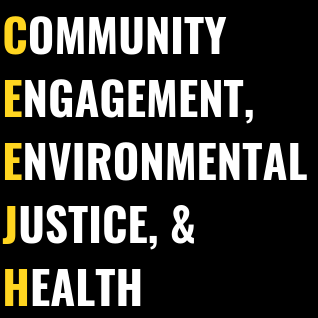COURSES
MIEH330:
ENVIRONMENTAL JUSTICE, RACISM, and ENVIRONMENTAL HEALTH DISPARITIES: HOW WHERE YOU LIVE CAN KILL YOU
Course Description: The environmental justice movement has been instrumental in providing a framework for communities to address social and environmental inequalities. From Dr. Martin Luther King Jr's work with the Memphis Sanitation Workers Strike, the PCB landfill fight in Warren County, NC, to current fights against industrial animal production and fracking in Appalachia, community activists, advocates, and other stakeholders have organized to stop the siting and operation of locally unwanted land uses (LULUs) and environmental hazards in communities of color, poor neighborhoods, and other locations where the population may be underserved and marginalized. Academic researchers have helped in this movement by using various methods to assess the disparate burden of environmental hazards on populations of color, the poor, indigenous populations, immigrants, and other vulnerable groups. Exposures to environmental hazards have been linked to public health and social, economic, and political injustice. In this course, students will learn environmental justice history, theory and science; discuss linkages between the physical, natural, and social environments and environmental injustice; examine how environmental injustice can lead to adverse health conditions and environmental health disparities; discuss environmental justice case studies; and learn about tools that can be used to understand and address environmental justice issues including Geographic Information Systems (GIS) such as EJSCREEN, health impact assessment (HIA), community-based participatory research (CBPR), and policy initiatives. We will draw on methods, theory, and data from environmental health sciences, health behavior and health education, sociology, urban planning, geography, epidemiology, anthropology, political science, law, and other fields of study.
MIEH331:
BUILT ENVIRONMENT, SUSTAINABILITY, AND PUBLIC HEALTH: THE GOOD, THE BAD, AND THE UGLY
Course Description: The built environment includes all of the physical parts of where we learn, live, work, play, and pray. The built environment includes housing, transportation systems, food infrastructure, municipal buildings, schools, commercial spaces, and industry. When we think about the built environment, we think of places including neighborhoods, parks, and communities. The built environment can have both positive and negative ecologic features that can influence health at the individual, population, and community level. Issues such as urban sprawl, substandard housing, transportation inequities, lack of access to environmental amenities including parks and green space, poor access to food resources including grocery stores and the overabundance of fast food restaurants, the presence of locally unwanted land uses and environmental hazards such as chemical plants and incinerators, and limited pedestrian friendly infrastructure can lead to negative health behaviors and adverse health outcomes including obesity, diabetes, asthma, heart disease, declines in mental health, and premature mortality. However, planning and development initiatives that follow a sustainability framework can help make communities healthier, greener, and more sustainable. In this course, students will learn about built environment issues, urban health, theories and concepts of behavior and design, urban sprawl and transportation planning, social capital, physical activity, air and water quality, health disparities, and solutions and strategies to built environment problems including smart growth, health impact assessment, and equitable development.
MIEH730:
ENVIRONMENTAL JUSTICE, BUILT ENVIRONMENT, AND HEALTH DISPARITIES
Course Description: The environmental justice movement has been instrumental in providing a framework for communities to address social and environmental inequalities. From Dr. Martin Luther King Jr's work with the Memphis Sanitation Workers Strike, the PCB landfill fight in Warren County, NC, to current fights against industrial animal production and fracking in Appalachia, community activists, advocates, and other stakeholders have organized to stop the siting and operation of locally unwanted land uses (LULUs) and environmental hazards in communities of color, poor neighborhoods, and other locations where the population may be underserved and marginalized. Academic researchers have helped in this movement by using various methods to assess the disparate burden of environmental hazards on populations of color, the poor, indigenous populations, immigrants, and other vulnerable groups. Exposures to environmental hazards have been linked to public health and social, economic, and political injustice. In this course, students will learn environmental justice history, theory and science; discuss linkages between the physical, natural, and social environments and environmental injustice; examine how environmental injustice can lead to adverse health conditions and environmental health disparities; discuss environmental justice case studies; and learn about tools that can be used to understand and address environmental justice issues including Geographic Information Systems (GIS) such as EJSCREEN, health impact assessment (HIA), community-based participatory research (CBPR), and policy initiatives. We will draw on methods, theory, and data from environmental health sciences, health behavior and health education, sociology, urban planning, geography, epidemiology, anthropology, political science, law, and other fields of study.
